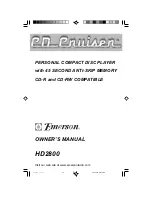
4
Safety Instructions for Thickness Planer (continued)
Before each use, make sure area under the cutter head
and feed rollers is clear.
If any part of this thickness planer is missing, bent, or bro-
ken in any way, or any electrical parts don’t work, turn the
thickness planer off and unplug it. Replace damaged, miss-
ing, or failed parts before using the thickness planer again.
To reduce possibility of thrown pieces, make sure the
knives are properly installed and the knife lock screws
are tight.
Use sharp knives. Dull or knicked knives tend to “pound”
and chew at the wood, causing kickbacks.
Replace dull or damaged planer knives.
Make sure the dust chute is in place.
Keep Guards In Place, in working order, and in proper
adjustment.
Maintain Tools With Care. Keep the thickness planer
clean for best and safest performance. (See “Mainte-
nance” section) DON’T lubricate any part of the thickness
planer while the knives are rotating.
To Reduce The Risk Of Injury From Jams, Slips Or Thrown Pieces
• Use Only Recommended Accessories. (See “Acces-
sory” section). Consult this Owner’s manual for recom-
mended accessories. Follow the instructions that come
with the accessories. The use of improper accessories
may cause injury to persons.
• Keep Work Area Clean. Cluttered areas and benches
invite accidents. Floor must not be slippery.
To reduce the risk of burns or other fire damage, never
use the thickness planer near flammable liquids, vapors
or gases.
Plan Ahead To Protect Your Eyes, Hands, Face and Ears
Know Your Thickness Planer. Read and understand
the owner’s manual and labels affixed to the tool. Learn
its applications and limitations as well as the specific
potential hazards peculiar to this tool.
To reduce the risk of injury from accidental contact with
moving parts, don’t do layout, assembly, or setup work on
the thickness planer while any parts are moving.
Reduce the Risk of Accidental Starting. Make sure
switch is “OFF” before plugging thickness planer into a
power outlet.
Plan your work.
Use the right tool. Don’t force planer to do a job it was
not designed to do.
Dress For Safety
Any power tool can throw foreign objects into the eyes.
This can result in permanent eye damage. Wear safety
goggles (not glasses) that comply with ANSI Z87.1 (or in
Canada CSA Z94-3-M88) shown on package. Everyday
eyeglasses have only impact resistant lenses. They are
not safety glasses. Safety goggles are available at many
local retail stores. Glasses or goggles not in compliance
with ANSI or CSA could seriously hurt you when they
break.
• Do not wear loose clothing, gloves, neckties or jewelry
(rings, wrist watches) They can get caught and draw
you into moving parts.
• Wear nonslip footwear.
• Tie back long hair.
• Roll long sleeves above the elbow.
• Noise levels vary widely. To reduce the risk of possible
hearing damage, wear ear plugs or muffs when using
thickness planer for hours at a time.
• For dusty operations, wear a dust mask along with
safety goggles.
Keep hands at least (8") 20cm from the outfeed. Don’t
grip board tightly or pull board. A sudden kickback could
pull hand into cutters.
Keep hands away from moving parts.
Inspect Your Workpiece
• Make sure there are no nails or foreign objects in the
part of the workpiece to be planed.
• Use quality lumber. Knives last longer and cuts go
smoother on good wood.
• Do not plane undersized wood. Boards which are thin-
ner than 1/8" or shorter than 12" could split while being
planed.
• Plane boards (12”) 30cm or longer only. Short boards
can jam or split and cause dangerous kickbacks.
• Use for solid wood and wood products only. Do not
plane metals, plastics or laminated materials.
Содержание TP13000
Страница 23: ...23 Notes...





































